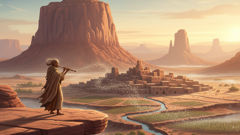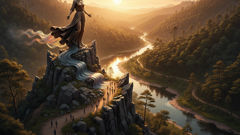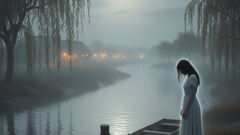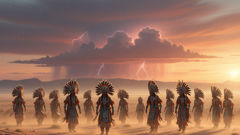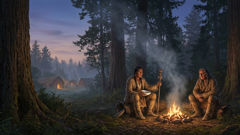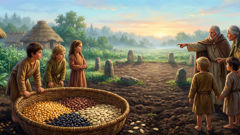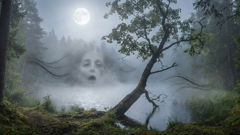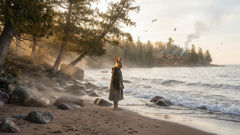Introduction
When dawn pulls a thin wash of gold across the canyon rims, there comes a single breath of music that travels the long corridors between sandstone and cloud. It is not wind alone but a tune that seems to carry the desert’s secret—an old promise braided into notes, a call that loosens dry earth and wakes the buried pulse beneath seeds. The people who tend the fields and patios of adobe pueblos know that sound by name: Kokopelli, the humpbacked flute player, a trickster and a bringer, a stranger who leaves both mischief and blessing in his wake. He walks with a loping gait that sounds like laughter and hollow reeds, and his hump is said to hold stories, seeds, small lives that he disperses like pollen. Some elders say he is the slow-spinning memory of long-ago travelers; others insist he is older than pleasure and sorrow and that he is the desert’s own way of remembering to renew herself. Children press their faces to the cool of the plaza stones to listen, women widen their palms to welcome rain, and the farmers listen for the cadence that will coax corn to lift, beans to twine, and hearts to open. This tale follows Kokopelli as he moves from ridge to river, mesa to valley, playing for a season when drought thinned the bones of the land and for hearts that had forgotten how to expect bloom. It is a story of music and mischief, of small, deliberate acts that become miracles, and of how a single flute can turn the direction of a life.
The Season of Thin Rivers
When the rivers fingered less water across the floodplain and the wells inched toward memory, the people of a particular valley began to speak in low, urgent sentences. Corn leaves curled like hands receding from light, and the beans strung their vines closer to the soil as if sheltering a secret. The valley’s elders—women who measured time by the weight of stored corn—met at the communal oven and spoke of the old songs that used to make clouds lean in. They told of past seasons when Kokopelli had passed through in a patchwork of footprints, and rain followed like a companion. But generations shift like sand, and songlines were thinned by years of quiet. The younger mothers no longer knew the exact rhythm that would rouse the clouds; their fingers remembered only how to weave baskets, not how to coax thunder from flute notes. The community felt itself caught between memory and present want.

On a morning where the air had the smell of hot stone and almonds, a child named Ana climbed the sofa-like buttress that jutted above the village. She had been taught to listen as a way of watching, and in her small chest the music was a thing she could hold. That morning the first notes came: low and mischievous, then high and insistent, like a conversation between a fox and the horizon. Kokopelli moved along the rim like a shadow with a song, his hump rising and falling; when he reached the edge above Ana, he tipped his head, and the tune poured down like a promise. He was not a god who demanded sacrifice; he was a traveler who favored tricks. He sang of buried seeds that wanted to wake. He sang of laughter, of lovers who had forgotten how to be brave, and of small jokes that unravelled fear. His flute was not a single tone but a braid of colors—some notes tasted of rain, others of warm sand, others of a child’s first laugh.
The people were wary. Tricksters bring both gifts and tests. An elder named Mateo warned the village against easy bargains: “A flute can charm the corn but fool the mind,” he said. Yet when Kokopelli’s music slipped across the plaza and through the reed fences, it touched things that even worry could not harden. The old dogs sat up; a pot of dried beans settled as if hearing its own name. Women who had prayed to the sky for a child felt a warmth in their hands that did not belong to them alone. Young men who had tied their lives to the land felt a loosened courage. Where Kokopelli paused to play, tiny shoots pushed up with unsentimental stubbornness—green like spoken truth. He played for an old woman who had not spoken for a year; the sound placed a new word on her tongue, and she began to tell a story she had buried. He played for a pair of brothers whose feud had been a wall for many seasons; one laughed so suddenly that the wall cracked, and the brothers found themselves sitting on the same rock, sharing water.
Kokopelli’s hump—said by some to contain seeds, by others fragments of songs and small lost things—was a mystery that invited curiosity. Children followed the faint footprints he left in the dust, which looked like musical notes pressed into soil. He left gifts that were both practical and strange: a pouch of blue stone that could guide underground moisture to thirsty roots, a strand of braided grass that would steady a child’s cradle, a single seed that sprouted into a plant bearing leaves that sang faintly when the wind passed through them. But his greatest offering was his insistence: the notion that the land, like people, could be coaxed into remembering life again. He did not grant rain immediately; he nudged rhythms back into circulation. The villagers learned to attend—watering by the flute’s measure, singing the call-and-response Kokopelli offered, tapping their pots and stomping rhythms that echoed his melody. They mended irrigation channels with hands and jokes and, slowly, the fields replied.
Yet it would be a mistake to call Kokopelli only a benefactor. The trickster in him delighted in disorder. Once, early in a spring that shimmered with potential, a young man named Julio took Kokopelli’s music for granted and tried to steal the hump’s pouch. He climbed where the flute-player had been sleeping in a patch of sage and, thinking himself clever, tugged at the hump. There was nothing violent in Kokopelli’s response—only a sharp, teasing trill that turned the young man’s hair silver for a season and filled his pockets with tiny cacti that felt like prickly coins. Julio returned to the village humbled and redder than a clay pot, and the prank re-taught the sense that debts in stories are not always monetary; sometimes they are lessons about humility and attention. The prank also returned a necessary laughter to the valley: laughter that loosened furrowed brows and allowed people to dance while waiting for clouds to form.
Kokopelli’s visits did not obey schedule. Sometimes he arrived at harvest, other times in the thin hours before planting. The people learned, reluctantly and gratefully, to live with that unpredictability. They fashioned small altars of sun-baked clay where children could leave a ribbon or a piece of dried corn as thanks. The story spread beyond that single valley. Travellers carried snatches of melody and a few of the unusual seeds, and villages from mesa to mesa remembered to pause when a thin flute note threaded through the air. The story of Kokopelli remained a living thing precisely because it was not legislated; it came in fragments, jokes, and practice, renewed by those who listened with curious hands.
Journeys of Wind and Seed
Kokopelli’s path is a map written in weather. He walks on ridgelines where air thins and on paths under starlight that lead to forgotten springs. To follow him is to learn the language of small changes: a bent reed that points where water still hides, a stone stacked like a question that becomes an answer when moved. There is an old tale—older still than any single family in the canyon—about the time Kokopelli crossed a desert so wide that even the stars seemed to hesitate. In that story, he met a woman named Marisol, who tended a lone garden in a basin where winds stripped soil dry. Marisol had married drought into the framework of her life; she had accepted the smallness of daily bread and avoided dreaming larger because dreaming had once cost her a child. When Kokopelli sat upon her fencepost and played, his melody found the thinest place in her armor: a secret wish she had for a life unshrunk by sorrow.

Kokopelli did not promise her children with a decree. Instead he offered an exchange—an awkward barter characteristic of tricksters. He taught her how to read the way light pooled under certain stones, where water gathered like a shy thing beneath tumbled rock, and how to fold laughter into the act of planting so that seeds would not be without witnesses when they pushed up. He also insisted that she learn to play and to play poorly at first—because humility is fertile ground for growth. Marisol’s hands became callused with both work and practice; sometimes her flute sounded thin and jagged, sometimes like rain on a tin roof. She learned to listen for small echoes: when her laugh conformed to the music, a particular wildflower would open. When she planted while humming a hollow note that matched the valley’s tone, beans climbed faster. The garden grew, not grandiose but steady, and the basin, which had been a measured sorrow, became a patch of insistence and tiny miracles.
Elsewhere, Kokopelli encountered travelers whose lives had stiffened from journeys without a companionable song. A lone shepherd had forgotten how to whistle and only hummed in the dark; Kokopelli crept into his camp and rearranged the stones around the fire so their shadows formed a flute. The next morning the shepherd found his whistle again—no thief of bright sound, merely a restored pattern. For a band of traders who had once bartered with jealousy and greed, Kokopelli swapped their heavy satchels with lighter ones that contained a single, carefully labeled seed: “Plant me where you quarrel, and return in a season.” The traders did as instructed and found that the ground where they had argued was now a small orchard where they finally ate together.
Kokopelli’s humor sometimes took a sharper edge, not cruel but instructive. In a canyon where ego had been stored like jars of dried peppers, a leader named Sefu believed himself invulnerable to small human follies. Kokopelli, who dislikes arrogance with the same steady dislike as he enjoys a good joke, arranged the wind so that Sefu’s robe billowed at an inopportune moment and sent him slipping into a lather of dust. The leader learned how to stand again and how to laugh about the dust that would not stay. That laughter stitched a tiny seam in the community fabric that allowed an overflow of compassion. In Kokopelli’s ledger, lessons and mercy are not opposites but part of a single recipe.
What often surprises those who encounter Kokopelli in these stories is the intimacy of his interventions. He is not a far-off force but a close teacher: his hands fold up small miracles in the hollows of his robe. He shows an old potter how to shape a vessel so that its mouth captures dew at dawn, how to keep water longer; he teaches a midwife a whispered cadence to steady breath during labor. Yet Kokopelli’s offerings always expect a reciprocation that is simple: attention, practice, and reciprocity. People planted songs along with seeds; they sang as they repaired terraces and recited the names of those they had lost as they mended fences. The music spread through labor and daily acts; it was not merely entertainment but a method.
Perhaps the most enduring image is the hump itself, which sometimes appears as a sack of seeds and sometimes as a bundle of stories. The hump reminds listeners that what is carried into the world is a blend of need and abundance: the trickster’s burden is both a burden for him and a gift for others. In the end, Kokopelli’s journeys are not about domination of the land or people but about reminding both that cycles can be coaxed and that each small act—an offering of water, a mended ditch, a joke shared over supper—accumulates. Seasons lengthen their notes and, by repetition, become habit, and habit becomes culture. The desert learns to sing again, and people learn to listen.
Throughout the valleys and mesas, the flute’s melody formed a loose network of caretakers who refused to let knowledge die. They placed stones in patterns to mark places where Kokopelli had once paused. They embroidered his likeness into blankets, not as an idol but as an image of a practice—a call to play, to tend, to remember. In this way the figure of Kokopelli remained humble: a reminder that the work of tending life is both ordinary and miraculous. The trickster’s footprint—light and musical, never fully traced—reminds us that community is a continuing improvisation, that fertility and mischief can coexist, and that every song eventually comes back to those who keep their ears open.
Conclusion
Stories like this one live because they are practices disguised as entertainment. Kokopelli’s music is a lesson without a scold: play, tend, and coax what is latent into being. He teaches that fertility is not merely a biological happenstance but a covenant between hands and soil, between song and season. His tricks remind us to hold humility as tenderly as we hold our tools. Above all, the tale honors a persistence of care—the patient repetition of small acts that, season after season, remake a landscape and the people who inhabit it. In the hush after a flute dies away, you may still hear a distant rhythm in the stones and the fields, a leftover of wind and wisdom that encourages anyone who listens to plant, to mend, and to laugh. The desert will likely forget and forgive more than a city might; it holds room for mischief so long as that mischief returns with seeds. Keep your hands open, your feet steady, and when you hear a thin reed note at dawn, let your heart answer. Remember, in kindness and in jest, that songs can call water and that small actions are how a drought is undone.

